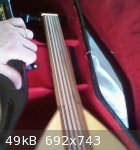Cocomaan
Oud Lover
 
Posts: 16
Registered: 2-8-2010
Member Is Offline
|
|
Neck Length
I own a pretty standard student (cheap) oud that I bought when I lived in Cairo. It's tuned to the standard CFADGC.
My question is this - the neck on this oud is pretty long, and from watching youtube videos, I see a lot of ouds with shorter necks. I wouldn't think
this was a problem, except that when I'm practicing, especially on the D string, it feels like my pinky finger is not going to reach that F#. Seems
strange, and I thought you guys might know why. It feels awkward to try to play hijaz and you have to move your whole hand down the neck to get to the
f#.
I am about 3 months into serious practicing on the oud. Things are progressing pretty well. I'll take pictures if anyone thinks it will help. Does it
have to do with what pegs I put the D strings on?
I plan on buying a nicer instrument once I feel like I've gotten good enough to appreciate the difference  ) )
|
|
|
fernandraynaud
Oud Junkie
    
Posts: 1865
Registered: 7-25-2009
Location: San Francisco, California
Member Is Offline
Mood: m'Oudy
|
|
Nothing to do with what peg ...
On the oud the place where the neck joins the body is special. It's exactly 1/3 of the way to the bridge. Using Western terminology, if your
instrument is tuned correctly in ascending fourths, and if you finger on this place on a string it will play the same note as if you play the string
below it, but an octave higher. On the D string this "fret" will play A, and the string below the D string should be tuned to A an octave lower. So if
your neck is different and does not behave like this, if it is shorter or longer, what you have is not an oud. There are countless variants on the
lute theme from all over the world, and some even look a lot like an oud. The position of the neck-body joint on the fretboard is just one of many
characteristics that "make an oud", but it's one of them for sure. Playing harmonics at the neck-body joint and the note two half steps lower is an
excellent way to tune the oud.
|
|
|
Luttgutt
Oud Junkie
    
Posts: 578
Registered: 1-10-2009
Location: Norway
Member Is Offline
Mood: Curious
|
|
Hi cocomaan!
In addition to what Fernand says:
1- oud size varies a lot. Most of the ouds have neck anywhere between 19 cm and 20,5 cm. So HOW much longer is your ouds neck?
p.s. this 1,5cm in differance makes the oud actually MUCH bigger!!
2- If you are a begginer, reaching the F# is NEVER easy at the beginning. Especially on Hijaz, since the "jump" is too big for a beinner. So don't be
discouraged!!
p.s. and the longer the neck, the more difficult it is.
Good luck and welcome on board
The wood might be dead, but the oud is alive.
|
|
|
Cocomaan
Oud Lover
 
Posts: 16
Registered: 2-8-2010
Member Is Offline
|
|
So, you're saying that, on an oud, I should be able to play an A natural on the D string by putting my finger on the string where the neck meets the
body of the oud. Mine sort of does that...
I am attaching pictures to give you an idea of what it looks like and the label on the oud.
Quote: Originally posted by fernandraynaud  | Nothing to do with what peg ...
On the oud the place where the neck joins the body is special. It's exactly 1/3 of the way to the bridge. Using Western terminology, if your
instrument is tuned correctly in ascending fourths, and if you finger on this place on a string it will play the same note as if you play the string
below it, but an octave higher. On the D string this "fret" will play A, and the string below the D string should be tuned to A an octave lower. So if
your neck is different and does not behave like this, if it is shorter or longer, what you have is not an oud. There are countless variants on the
lute theme from all over the world, and some even look a lot like an oud. The position of the neck-body joint on the fretboard is just one of many
characteristics that "make an oud", but it's one of them for sure. Playing harmonics at the neck-body joint and the note two half steps lower is an
excellent way to tune the oud.
|

|
|
|
Cocomaan
Oud Lover
 
Posts: 16
Registered: 2-8-2010
Member Is Offline
|
|
Here's another picture.

|
|
|
Cocomaan
Oud Lover
 
Posts: 16
Registered: 2-8-2010
Member Is Offline
|
|
By the way, thanks for the help to both of you guys.
1. Measuring from the "Crease" where the neck meets the body, it's about 20.8cm, which seems like it's a lot longer.
2. Any tips on making that jump to hijaz? I had a feeling this jump might be a problem for many beginners (never seen that mentioned however). I am
right in saying that the jump would be "longer" when the neck of the oud is longer? Do you yourself move your thumb when you play the F#? or get it
with the pinky finger?
Saba is my favorite maqam, but that F# makes it harder to play than it already is!
Quote: Originally posted by Luttgutt  | Hi cocomaan!
In addition to what Fernand says:
1- oud size varies a lot. Most of the ouds have neck anywhere between 19 cm and 20,5 cm. So HOW much longer is your ouds neck?
p.s. this 1,5cm in differance makes the oud actually MUCH bigger!!
2- If you are a begginer, reaching the F# is NEVER easy at the beginning. Especially on Hijaz, since the "jump" is too big for a beinner. So don't be
discouraged!!
p.s. and the longer the neck, the more difficult it is.
Good luck and welcome on board
|
|
|
|
fernandraynaud
Oud Junkie
    
Posts: 1865
Registered: 7-25-2009
Location: San Francisco, California
Member Is Offline
Mood: m'Oudy
|
|
Measure from the nut to the neck-body crease, call that X, and measure the whole scale from nut to bridge, call that Y. X should equal Y / 3.
|
|
|
Luttgutt
Oud Junkie
    
Posts: 578
Registered: 1-10-2009
Location: Norway
Member Is Offline
Mood: Curious
|
|
1- Yes, the longer the finger board, the bigger the jump.
2- 20,8cm is a big oud (I think I have not seen many bigger ouds). I once had one that was 21cm. I gave it away to charity 
3- Yes I use my litle finger for the F#. without moving the thumb.
P.s. you can kind of "twist" your rist to reach it, since you have such a big oud.
P.s. Tony, I love those X's and Y's 
The wood might be dead, but the oud is alive.
|
|
|